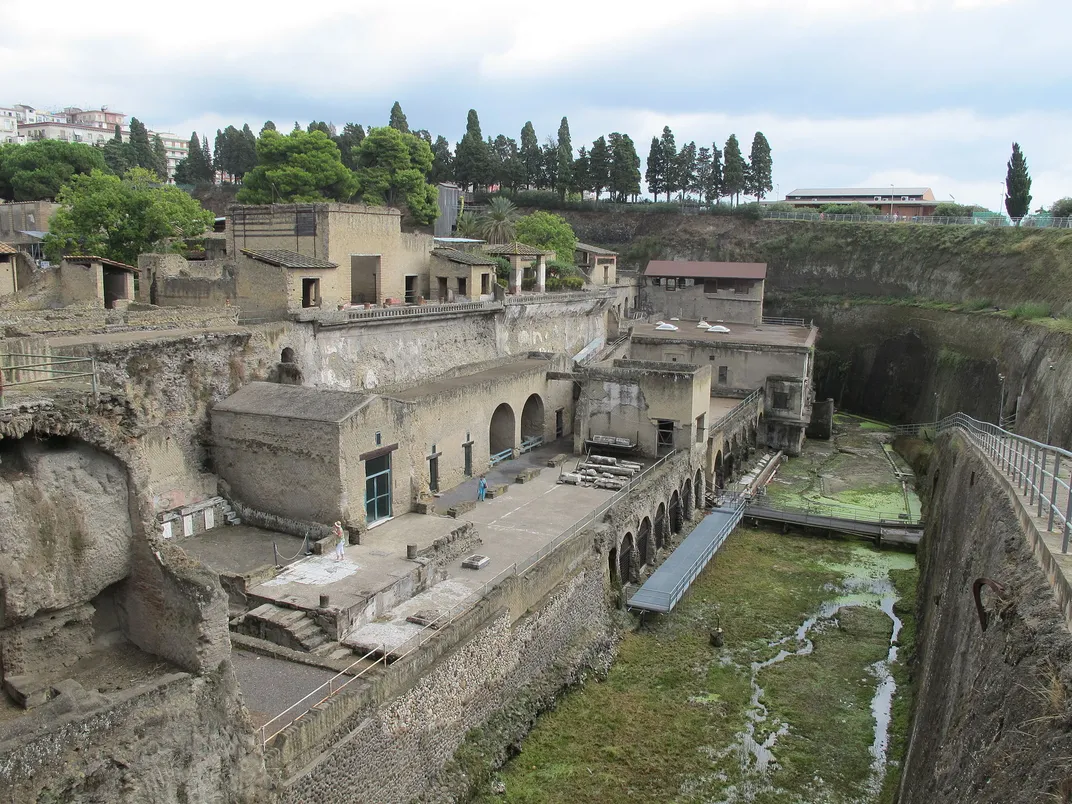Well-Preserved Brain Cells Found in Vesuvius Victim
The volcanic eruption transformed the young man’s neural tissue into glass
:focal(841x577:842x578)/https://tf-cmsv2-smithsonianmag-media.s3.amazonaws.com/filer/28/72/2872d82f-b066-49f2-a41f-1001a31d4251/neurons.png)
In 79 A.D., Mount Vesuvius showered the Roman city of Pompeii and its southern neighbor Herculaneum with waves of scorching ash and rock. Hundreds of Herculaneum residents fled to the waterfront, where they succumbed to a pyroclastic surge that boiled their blood and made their skulls explode—but a select few stayed behind in the seaside town.
One of the individuals who remained in Herculaneum was a young man in his 20s. He died splayed out, facedown and possibly asleep on a wooden bed in his chambers. Archaeologists think he may have worked as a guard at the nearby College of Augustales, an imperial cult dedicated to the emperor Augustus, as Brigit Katz wrote for Smithsonian magazine earlier this year.
Two millennia after the infamous volcanic eruption, a new study published in the journal PLOS One adds to a growing body of evidence suggesting shards of strange black matter recovered from the unlucky man’s remains are indeed remnants of his brain. As Stephanie Pappas reports for Live Science, researchers used scanning electron microscopy to identify tiny spherical and tubular structures that resemble neurons, or brain cells, in the sample.

The man’s well-preserved body rested undisturbed until the 1960s, when it was recovered by archaeologists. In 2018, lead author Pier Paolo Petrone, a forensic anthropologist at the University of Naples Federico II, discovered a striking piece of archaeological evidence while examining the body: pieces of a glassy, obsidian-like material peeking out of the man’s skull, he tells CNN’s Rory Sullivan and Sharon Braithwaite.
Upon further study, Petrone and his colleagues realized that the shards appeared to be bits of ancient brain matter that were vitrified—or literally turned to glass—by the extraordinary heat of Vesuvius’ explosion. The researchers announced their theory in the New England Journal of Medicine in January, noting that the sample contained many proteins commonly found in the human brain.
The new findings appear to confirm the team’s suspicions, offering a unique glimpse into what the paper deems “possibly the best-known example in archaeology of extraordinarily well-preserved” brain tissue.
As Petrone says to Agence France-Presse, “The experimentation continues on several research fields, and the data and information we are obtaining will allow us to clarify other and newer aspects of what happened 2,000 years ago during the most famous eruption of Vesuvius.”
Based on the proteins and structure of cells discovered in the vitrified remains, the researchers think they have found part of the man’s brain and spinal cord.
The authors further hypothesize that the “conversion of human tissue into glass is the result of sudden exposure to scorching volcanic ash and the concomitant rapid drop in temperature.”
/https://tf-cmsv2-smithsonianmag-media.s3.amazonaws.com/filer/d6/c3/d6c3f9bc-0e05-4310-81a0-0b730a9cb37f/diagram.jpg)
Petrone and his team argue that a wave of hot volcanic ash that descended on Herculaneum “froze” the man’s neuronal structures. Subsequent rapid cooling transformed the human tissue into glass.
Preserved ancient brain tissue is a rare—but possible—occurrence, reports Jennifer Ouellette for Ars Technica.
“Brain tissue does preserve and it’s a lot more common than people imagine,” Alexandra Hayward, a bioarchaeologist at the University of Copenhagen who was not involved in the study, tells Ars Technica.
Speaking with CNN, co-author Guido Giordano, a volcanologist at Roma Tre University, says charred wood discovered near the man’s body suggests Vesuvius’ explosion incinerated the site, which reached temperatures of more than 500 degrees Celsius (932 degrees Fahrenheit) during the disaster.
Giordano notes that the discovery of brain cell structures is “totally unprecedented” in the study of this region.
He adds, “This opens up the room for studies of these ancient people that have never been possible.”
/https://tf-cmsv2-smithsonianmag-media.s3.amazonaws.com/accounts/headshot/nora.png)
/https://tf-cmsv2-smithsonianmag-media.s3.amazonaws.com/accounts/headshot/nora.png)